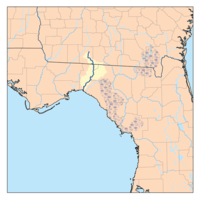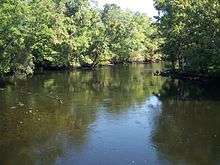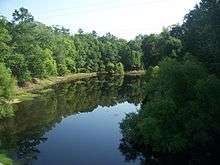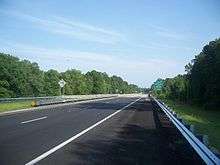Aucilla River

The Aucilla River rises close to Thomasville, Georgia, USA, and passes through the Big Bend region of Florida, emptying into the Gulf of Mexico at Apalachee Bay. Some early maps have it called the Ocilla River. The river is 89 miles (143 km) long and has a drainage basin of 747 square miles (1,930 km2). The Wacissa River is a tributary. In Florida, the Aucilla River forms the eastern border of Jefferson County, separating it from Madison County on the northern part, and from Taylor County to the south.[1] The lower part of the river disappears underground and reappears several times, and is known as the Aucilla River Sinks.[2] The Aucilla River is a rich source of late Pleistocene and early Holocene animal bones and human artifacts, and is the subject of the Aucilla River Prehistory Project, which includes the Page-Ladson prehistory site.[3] During the first Spanish period in Florida the Aucilla River was the boundary between the Apalachee people and the Timucua-speaking Yustaga (or Uzachile) people.[4]
Near Boston, Georgia the Aucilla River temporary becomes a subterranean river at Howell Sinks.
Crossings
See also
- List of fossil sites (with link directory)
- South Atlantic-Gulf Water Resource Region
![]() Media related to Aucilla River at Wikimedia Commons
Media related to Aucilla River at Wikimedia Commons
References
- ↑
- Shukovsky, Paul. 1990. Aucilla River. in Marth, Del and Marty Marth, eds. The Rivers of Florida. Sarasota, Florida: Pineapple Press, Inc. ISBN 0-910923-70-1.
- ↑ "Big Bend Salt Water Paddling Trail: Aucilla River - Econofina River" (PDF). Florida Fish and Wildlife Commission. p. 14. Retrieved 30 September 2014.
- ↑ Aucilla River Prehistory Project - retrieved March 12, 2006
- ↑ Milanich, Jerald T.; Hudson, Charles (1993). Hernando de Soto and the Indians of Florida. Gainesville, Florida: University Press of Florida. p. 211.
- ↑ [http://viewer.nationalmap.gov/viewer/?p=default&b=base1&q=30.7424222 -83.7869105 "USGS TNM 2.0 Viewer"]. United States Geological Survey. Retrieved 2 October 2015.
Further reading
- Balfour, R. C. 2002. In Search of the Aucilla. Colson Printing Company, Valdosta, GA.
- Balsillie, J. H., G. H. Means, and J. S. Dunbar. 2006. The Ryan/Harley site: Sedimentology of an inundated Paleoindian site in north Florida. Geoarchaeology 21:363-391.
- Dunbar, J. S. 2006. Pleistocene-Holocene Climate Change: Chronostratigraphy and Geoclimate of the Southeast United States, Chapter 5. Pages 103-158 in S. D. Webb, ed. First Floridians and Last Mastodons: the Page-Ladson Site on the Aucilla River. Springer Press, Dordrecht, The Netherlands.
- Dunbar, J. S., C. A. Hemmings, P. K. Vojnovski, S. D. Webb, and W. Stanton. 2005. The Ryan/Harley Site 8Je1004: A Suwannee Point Site In The Wacissa River, North Florida. Pages 81–96 in R. Bonnichsen, B. T. Lepper, D. J. Stanford, and M. R. Waters, eds. Paleoamerican origins: beyond Clovis. Center for the Study of the First Americans, Texas A&M University Press, College Station, TX.
- Dunbar, J. S., S. D. Webb, and M. K. Faught. 1988. Page/Ladson (8Je591): An Underwater Paleo-Indian Site in Northwestern Florida. Florida Anthropologist 41:442-452.
- Fisher, D. C. and D. L. Fox. 2006. Five Years in the Life of an Aucilla River Mastodon. Pages 343-377 in S. D. Webb, ed. First Floridians and Last Mastodons: the Page-Ladson Site on the Aucilla River. Springer, Dordrecht, the Netherlands.
- Hoppe, K. A. and P. Koch. 2006. The Biogeochemistry of the Aucilla River Fauna, Chapter 13. Pages 379-401 in S. D. Webb, ed. First Floridians and Last Mastodons: the Page-Ladson Site on the Aucilla River. Springer Press, Dordrecht, The Netherlands.
- Hoppe, K. A. and P. L. Koch. 2007. Reconstructing the migration patterns of late Pleistocene mammals from northern Florida, USA. Quaternary Research 68:347-352.
- Newsom, L. A. and M. Mihlbachler. 2006. Mastodons (Mammut americanum) Diet Foraging Patterns Based on Analysis of Dung Deposits, Chapter 10. Pages 263-331 in S. D. Webb, ed. First Floridians and Last Mastodons: the Page-Ladson Site on the Aucilla River. Springer Press, Dordrecht, The Netherlands.
- Newsom, L. A. 2006. Paleoenvironmental Aspects of the Macrophytic Plant Assemblage from Page-Ladson, Chapter 7. Pages 181-211 in S. D. Webb, ed. First Floridians and Last Mastodons: the Page-Ladson Site on the Aucilla River. Springer Press, Dordrecht, The Netherlands.
- Serbousek, D. 1983. Explorations of a Paleo-Indian site on the Aucilla River. Florida Anthropologist 36:88-97.
- Webb, S. D. 1974. Underwater Paleontology of Florida's Rivers. National Geographic Society Research Reports 1968 Projects:479-481.
- Webb, S. D. 2006. First Floridians and last Mastodons: the Page-Ladson site in the Aucilla River. Springer, Dordrecht, The Netherlands.
- Webb, S. D. and J. S. Dunbar. 2006. Carbon Dates, Chapter 4. Pages 83–102 in S. D. Webb, ed. First Floridians and Last Mastodons: the Page-Ladson Site on the Aucilla River. Springer Press, Dordrecht, The Netherlands.
- Webb, S. D. and C. A. Hemmings. 2001. Ivory and bone tools from late Pleistocene deposits in the Aucilla and Wacissa River, North-Central Florida. Pages 1–8 in B. A. Purdy, ed. Enduring records: the environmental and cultural heritage of wetlands. Oxbow Books, Oxford, England.
- Webb, S. D., J. T. Milanich, R. Alexon, and J. S. Dunbar. 1984. A Bison antiquus Kill Site, Wacissa River, Jefferson County, Florida. American Antiquity 49:384-392.
- U.S. Geological Survey Geographic Names Information System: Aucilla River
Coordinates: 30°5′9″N 83°59′25″W / 30.08583°N 83.99028°W


